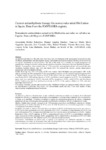Mostrar o rexistro simple do ítem
Current antiarrhythmic therapy for nonvalvular atrial fibrillation in Spain: data from the FANTASIIA registry
| dc.contributor.author | Roldán, Inmaculada | |
| dc.contributor.author | Anguita, Manuel | |
| dc.contributor.author | Marín, Francisco | |
| dc.contributor.author | Quesada, María Angustias | |
| dc.contributor.author | Camacho Siles, José | |
| dc.contributor.author | Peinado, Rafael | |
| dc.contributor.author | Bertomeu, Vicente | |
| dc.contributor.author | Cequier, Ángel | |
| dc.contributor.author | Badimón, Lina | |
| dc.contributor.author | Muñiz, Javier | |
| dc.date.accessioned | 2015-08-25T11:13:18Z | |
| dc.date.issued | 2015-06-18 | |
| dc.identifier.citation | Roldán Rabadán I, Anguita Sánchez M, Marín F, Quesada MA, Camacho Siles J, Peinado R. Current antiarrhythmic therapy for nonvalvular atrial fibrillation in Spain: data from the FANTASIIA registry. Rev Esp Cardiol. 2015 Jun 18. Epub | es_ES |
| dc.identifier.uri | http://hdl.handle.net/2183/14877 | |
| dc.description.abstract | [Abstract] Introduction and objectives. Recently, there have been many developments in the management of nonvalvular atrial fibrillation, antiarrhythmic and anticoagulant therapy, and nonpharmacological treatment, but these developments are not applied immediately in clinical practice. The aim of this study was to identify the overall management and antiarrhythmic therapy used in the current general population of patients with nonvalvular atrial fibrillation in Spain. Methods. A prospective, observational study of 1318 consecutive anticoagulated patients with nonvalvular atrial fibrillation, recruited between June 2013 and March 2014. We analyzed the patients’ general characteristics, management, and antiarrhythmic therapy. Results. Mean age was 73.8 ± 9.4 years; 42.5% were women. Atrial fibrillation was paroxysmal in 28% of the patients, permanent in 50%, persistent in 17.6%, long-standing persistent in 4.5%, and new-onset in 66 patients (5%). A rhythm control strategy was chosen in 39.4% of the patients and rate control in 60.6%. Beta-blockers were prescribed in 60.2% of the patients, digoxin in 19.5%, and calcium channel antagonists in 10.7%. The antiarrhythmic agents used were amiodarone (12.6%), flecainide (8.9%), propafenone (0.4%), sotalol (0.5%), and dronedarone (2.3%). Cardioversion had been performed previously in 41.9% of the patients, ablation in 3.4%, and atrial appendage closure in 0.2%. Conclusions. Currently, patients with nonvalvular atrial fibrillation in Spain are managed mainly with rate control, and beta-blockers in particular. They receive few antiarrhythmic agents and only a very small number of these patients undergo nonpharmacological treatments. | es_ES |
| dc.description.abstract | [Resumen] Introducción y objetivos. Recientemente se han producido numerosas novedades en el manejo de la fibrilación auricular no valvular y el tratamiento antiarrítmico, anticoagulante y no farmacológico empleado, pero su aplicación a la clínica no es inmediata. El objetivo del trabajo es conocer las características generales de manejo y tratamiento antiarrítmico de una población general de pacientes con fibrilación auricular no valvular actualmente en España. Métodos. Estudio observacional y prospectivo de 1.318 pacientes consecutivos con fibrilación auricular no valvular, anticoagulados y reclutados entre junio de 2013 y marzo de 2014. Se analizan sus características generales, el manejo y el tratamiento antiarrítmico utilizado. Resultados. La media de edad era 73,8 ± 9,4 años; eran mujeres el 42,5%. La fibrilación auricular fue paroxística en el 28% de los casos, permanente en el 50%, persistente en el 17,6%, persistente de larga duración en el 4,5% y de novo en 66 pacientes (5%). Se eligió control del ritmo en el 39,4% de los casos y de frecuencia en el 60,6%. Tomaron bloqueadores beta el 60,2%, digoxina el 19,5% y antagonistas del calcio el 10,7%. Los antiarrítmicos empleados fueron amiodarona (12,6%), flecainida (8,9%), propafenona (0,4%), sotalol (0,5%) y dronedarona (2,3%). Se realizó cardioversión previa en el 41,9%, ablación en el 3,4% y cierre de orejuela en el 0,2%. Conclusiones. Actualmente en nuestro país se maneja a los pacientes con fibrilación auricular no valvular preferentemente con control de frecuencia, sobre todo con bloqueadores beta, reciben pocos antiarrítmicos y se los somete en muy baja proporción a tratamientos no farmacológicos. | es_ES |
| dc.language.iso | eng | es_ES |
| dc.publisher | Elsevier | es_ES |
| dc.relation.uri | http://dx.doi.org/10.1016/j.rec.2015.03.004 | es_ES |
| dc.rights | Creative Commons Licence | es_ES |
| dc.rights | Reconocimiento-NoComercial-SinObraDerivada 4.0 Internacional | |
| dc.rights.uri | http://creativecommons.org/licenses/by-nc-nd/4.0/ | |
| dc.subject | Nonvalvular atrial fibrillation | es_ES |
| dc.subject | Antiarrhythmic therapy | es_ES |
| dc.subject | Cardioversion | es_ES |
| dc.subject | Ablation | es_ES |
| dc.subject | FANTASIIA registry | es_ES |
| dc.subject | Fibrilación auricular no valvular | es_ES |
| dc.subject | Tratamiento antiarrítmico | es_ES |
| dc.subject | Cardioversión | es_ES |
| dc.subject | Ablación | es_ES |
| dc.subject | Registro FANTASIIA | es_ES |
| dc.title | Current antiarrhythmic therapy for nonvalvular atrial fibrillation in Spain: data from the FANTASIIA registry | es_ES |
| dc.title.alternative | Tratamiento antiarrítmico actual de la fibrilación auricular no valvular en España: datos del Registro FANTASIIA | es_ES |
| dc.type | info:eu-repo/semantics/article | es_ES |
| dc.rights.access | info:eu-repo/semantics/openAccess | es_ES |
| dc.date.embargoEndDate | 2016-06-18 | es_ES |
| dc.date.embargoLift | 2016-06-18 |
Ficheiros no ítem
Este ítem aparece na(s) seguinte(s) colección(s)
-
GI- GRINCAR - Artigos [216]






